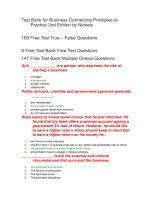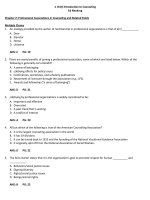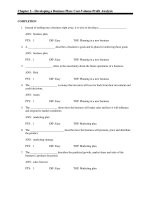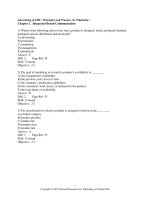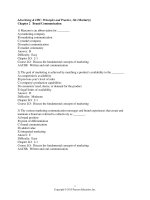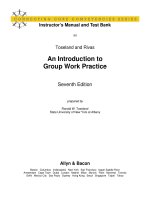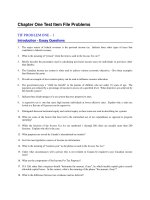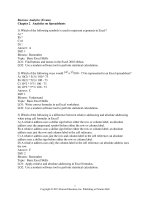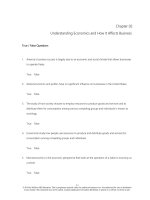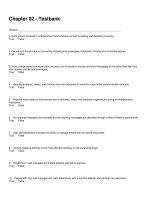Business connecting principles to practice 1st edition nickels test bank
Bạn đang xem bản rút gọn của tài liệu. Xem và tải ngay bản đầy đủ của tài liệu tại đây (678.65 KB, 197 trang )
Chapter 02 - Understanding How Economics Affects Business
Chapter 02
Understanding How Economics Affects Business
Test Planning Table for Chapter 2
LL:1
Knows Basic
Terms and Facts
LL:2
Understands
Concepts and
Principles
LL:3
Applies Principles
1. Explain basic
economics.
1,2,3,4,5,6,7,8,9,10,11,12,
13,14,15,16,17,18~,
167,168,169,170,171,172,
173,174,175,176
19,20,21,22,23,24,25,
26,
177,178,179,180,181,
182,183,184
27,28~,
185,186,187,188,189,
190~,191,
313,
318*
2. Explain what
capitalism is and how
free markets work.
29,30,31,32,33,34,35,36,
37,38,39,40,41,42,43,44,
45,46,47,48,49,50,51,52,
53,54,
192,193,194,195,196,197,
198,199,200,201,202,203,
204,205,206,207,208,209,
210,211,212
68,69,70,71,72,73,74,75,
76,77,78,79,80,81,82~,
230,231,232,233,234,235,
236,237,238
55,56,57,58,
213,214,215,216,217,
218,219,220,221
59,60,61,62,63,64,65,
66,67,
222,223~,224,225,226,
227,228,229~,
314,315,
323*
83,84,85,
239,240,241,242,243
86,87,
244,245,246,247,
319*
4. Analyze the trend
toward mixed economies.
88,89,90,91,92,93,
248,249,250,251,252
94,95,96,97~,98,
253~,254,255
99,100,101,102,
256,257,258,259,260
5. Describe the
economic system of the
United States, including
the significance of key
economic indicators
(especially GDP),
productivity, and the
business cycle.
6. Contrast fiscal policy
and monetary policy, and
explain how each affects
the economy.
103,104,105,106,107,108,
109,110,111,112,113,114,
115,116,117,118,119,120,
121,122,123,124,125,126,
127,128,129,
261,262,263,264,265,266,
267,268,269,270,271,272,
273,274,275
143,144,145,146,147,148,
149,150,151,152,
293,294,295,296,297,298,
299,300,301,302
130,131,132,133,134,
276,277,278,279,280
135,136,137,138,139,
140,141,142,
281,282,283,284,285,
286,287,288,289,290,
291,292,
316,
320*,321*
153,154,155,156,157,
158,159,160,
303,304,305,306,307
161,162,163,164,165,
166,
308,309,310,311,312,
317,
322*
Learning Goal
3. Compare socialism
and communism.
Total number of test items: 323
True/false questions are in plain text.
Multiple choice questions are in bold text.
Questions on boxed material are in bold text with a tilde~.
Essay questions are in bold underlined text.
Minicase questions are in bold with an asterisk*.
2-1
Chapter 02 - Understanding How Economics Affects Business
True / False Questions
1. America's business success is largely due to an economic and social climate that allows
businesses to operate freely.
True False
2. Global economics and politics have no significant influence on businesses in the United
States.
True False
3. The study of how society chooses to employ resources to produce goods and services and
to distribute them for consumption among various competing groups and individuals is known
as sociology.
True False
4. Economists study how people use resources to produce and distribute goods and services
for consumption among competing groups and individuals.
True False
5. Macroeconomics is the economic perspective that looks at the operation of a nation's
economy as a whole.
True False
6. Microeconomics focuses on the decisions and behavior of people and organizations in
particular markets.
True False
2-2
Chapter 02 - Understanding How Economics Affects Business
7. Resource development is concerned with finding the best way to utilize the fixed amount of
resources a society has available.
True False
8. Resource development is the study of how to increase resources and to create the
conditions that will make better use of those resources.
True False
9. Peace and prosperity will flourish if we can find the one best way to divide existing
resources among nations.
True False
10. Thomas Malthus believed that overpopulation was a major cause of poverty.
True False
11. In developing nations of the world, population has leveled off and is not expected to
increase dramatically in the future.
True False
12. Studies about the effects of population growth on the economy are part of
macroeconomics.
True False
13. Economic progress can occur when business owners provide jobs and economic growth
for their employees, their communities, and themselves.
True False
2-3
Chapter 02 - Understanding How Economics Affects Business
14. Economist Adam Smith's important contribution was an inquiry as to why some nations
are wealthy, while others remain poor.
True False
15. Adam Smith believed the self-interest of businesspeople would lead them to create needed
goods, services, and jobs.
True False
16. The "invisible hand" in Adam Smith's theory turns self-directed gain into social and
economic benefits for all.
True False
17. According to Adam Smith, the "invisible hand" refers to the government's effort to always
keep a check on the wealth creation of individuals, so that no one business would control a
market for a particular good or service.
True False
18. A contemporary economic challenge is creating profitable businesses by selling goods and
services that contribute toward a healthier environment.
True False
19. An economist is examining how consumers in the automobile market have responded to
recent price increases by car manufacturers. He is examining a microeconomic situation.
True False
20. Macroeconomics looks at long run economic problems while microeconomics examines
short run economic problems.
True False
2-4
Chapter 02 - Understanding How Economics Affects Business
21. Thomas Malthus believed that people in most countries would never be able to achieve
high standards of living unless the problems of overpopulation were addressed.
True False
22. Adam Smith believed that since businesspeople are motivated to improve their own
prosperity, their actions are unlikely to benefit society as a whole.
True False
23. Adam Smith believed that an economic system couldn't truly prosper unless people were
taught to value the welfare of others above their own personal gain.
True False
24. The concept of the invisible hand begins with the assumption that the primary motivation
of entrepreneurs is that they will prosper from their own hard work.
True False
25. Adam Smith's research focused on determining the best way to distribute a fixed amount
of resources, rather than on how to create more wealth.
True False
26. Large educated populations can contribute to an economy by offering knowledge and
entrepreneurship.
True False
27. Adam Smith believed that incentives to seek personal gain would create wealth, but that
the government must then step in to make sure that this wealth is equitably distributed.
True False
2-5
Chapter 02 - Understanding How Economics Affects Business
28. As indicated by the Making Ethical Decisions box, activities that lead to corruption can
destroy free economic opportunities because they interfere with the right to freely compete.
True False
29. In capitalist countries, the government decides what to produce and how the goods and
services will be produced.
True False
30. Capitalism is the foundation of the U.S. economic system.
True False
31. The most fundamental of all rights in capitalism is the right to private property.
True False
32. Under capitalism, the government prohibits people and businesses from competing with
each other.
True False
33. A basic right under capitalism is the right of businesses to receive government funding.
True False
34. Free-market capitalism has made it more difficult for individuals to gain wealth.
True False
35. Due to the fundamental rights afforded to us by a free-market capitalistic system; persons
are more willing to take calculated risks.
True False
2-6
Chapter 02 - Understanding How Economics Affects Business
36. A free-market economic system is one in which the market of buyers and sellers decides
what is produced, how much is produced, and how it is distributed.
True False
37. Under the basic principle of supply, as the price goes down, manufacturers and suppliers
of a product tend to supply less of the product to the market.
True False
38. Demand refers to the quantity of a good that consumers are willing and able to buy at
different prices at a specific time.
True False
39. Adapting to changes in demand is easy for businesses to do.
True False
40. At the equilibrium price, the quantity consumers desire to buy equals the quantity sellers
desire to sell.
True False
41. If the quantity supplied in a market exceeds the quantity demanded, a shortage will exist.
True False
42. If a shortage exists in a market for a good, the price of that good will tend to fall.
True False
43. A graphical representation of a demand curve for a product will show the price for any
particular quantity on the X-axis.
True False
2-7
Chapter 02 - Understanding How Economics Affects Business
44. The point of intersection between the supply and demand curves is called the stress point.
True False
45. In the long run, the market price tends to adjust toward the equilibrium point.
True False
46. Countries that rely on a free market system are plagued by persistent shortages or
surpluses of goods and services.
True False
47. One of the drawbacks of free markets is the fact that competition in such markets
undermines the ability of price to adjust to its equilibrium value in the long run.
True False
48. In perfect competition, each firm produces a product that is clearly differentiated from the
products of other firms in the same market.
True False
49. A monopoly occurs when there is a single seller for a product or service.
True False
50. Economists refer to a market in which a few sellers dominate the supply side as
monopolistic competition.
True False
51. Product differentiation is a key to success in monopolistic competition.
True False
2-8
Chapter 02 - Understanding How Economics Affects Business
52. In the United States, laws prohibit the creation of most types of monopolies.
True False
53. One strength of a free-market economic system is that it emphasizes the fair and humane
treatment of the less fortunate in society.
True False
54. The greed of businesspeople represents one of the greatest dangers to the operation of a
free market system.
True False
55. Fetna resides in a country where the economic system is primarily based on free market
capitalism. Fetna is likely to have the freedom to buy and sell property.
True False
56. A surplus currently exists for a product called widgets. In a free market system, the
government must step in and buy any widgets that consumers do not buy in order to eliminate
the surplus and establish equilibrium.
True False
57. In a free market economic system, the lack of government control and regulation means
that businesses find it easy to take advantage of customers by offering poor quality products at
high prices.
True False
58. History shows that free-market capitalism leads to a fair and equitable distribution of
wealth.
True False
2-9
Chapter 02 - Understanding How Economics Affects Business
59. Jill owns a bakery that specializes in cheesecakes. Until recently, Jill charged a price of
$12 for each cheesecake. At this price Jill's customers bought an average of 84 cheesecakes
each week. For the last few weeks, she has reduced her price to $10.50 per cheesecake, and
her customers have purchased an average of 96 cheesecakes each week. These results are
consistent with the economic concept of demand.
True False
60. Monica notices that just a few big companies produce the vast majority of soft drinks. She
would be correct in describing the soft drink industry as an oligopoly.
True False
61. GLAMOR GAL, a popular women's cosmetics company is gaining popularity among
younger women. Differentiating itself from the sea of companies that compete for the same
business, it focuses on products for sensitive, youthful skin. GLAMOR GAL clearly operates
in an oligopolistic environment.
True False
62. GLAMOR GAL is a popular cosmetics company. Although it is gaining in popularity
among younger women, its promotional strategy continues to focus on the shadow-free finish
that it produces on almost any skin type. Due to the fact that its industry faces monopolistic
competition, the company knows that it must continue to differentiate itself from the
competition.
True False
63. As you drive to school in the morning, you will probably flip through several radio
stations before deciding to settle on one for the duration of the drive. For instance: you can
listen to a "fair and balanced" talk show; an "intelligent talk" program; an interactive "call-in"
talk show; a "right-wing" political talk show; a "self-improvement" talk show; and, even an
"all sports" talk show. With so much monopolistic competition in radio programming, radio
stations focus on offering you something just a little different.
True False
2-10
Chapter 02 - Understanding How Economics Affects Business
64. Roland is a nation with an economic system that closely approximates pure capitalism.
While Roland's economy is likely to generate a great deal of wealth, it may do a poor job of
providing an acceptable level of income for the elderly or disabled.
True False
65. In the newspaper this morning, you read about the downfall of a multi-national
entertainment business, and a report that the company's CEO enjoyed a 9% increase in his
salary during the same year that the company's profits were down 35%. As you read further,
you learn that the company's board of directors approved undeserved salary increases.
Clearly, this is an example of how inequality and greed can infiltrate the free-market
economic system.
True False
66. As you scan the national news online, you read about the BXY Utility Company's latest
problems. The story describes an expansive retaining wall that collapsed during a flood last
week, spewing toxic coal ash, burying homes, and causing a few fatalities. An editorial claims
that the company will not be held accountable to the same standards as the asbestos
companies of a few years back that paid severe fines and even went out of business due to
their lack of attention to environmental clean-up. You agree with the writer because you
recently studied about the various competitive markets and utility companies clearly fall
under monopolistic competition.
True False
67. The PowerHouse Utility Company recently built a nuclear power plant in a southern state
and started competing against BXY Utility Company that has served customers in that region
for 65 years. Due to deregulation, consumers now have a choice among utility companies in
this area. Although PowerHouse has made a sizeable capital investment, if it successfully
grows market share, eventually prices for electricity may stabilize or fall.
True False
68. Socialists believe that the primary economic function of the government is to promote
rapid economic growth.
True False
2-11
Chapter 02 - Understanding How Economics Affects Business
69. In socialist economies, the government owns some, if not most basic businesses such as
telecommunications systems and utilities.
True False
70. The top tax rate on personal income in most socialist economies is usually lower than the
top tax rate on personal income in capitalist economies.
True False
71. The major benefit of socialism is that it creates strong incentives to work hard and take the
risks associated with starting and operating a business.
True False
72. Socialists believe that wealth should be more evenly distributed than what actually occurs
in a free-market capitalistic system.
True False
73. Workers in socialist countries often get longer vacations and more social benefits than
workers in free market economies.
True False
74. Over the past decade, socialist economies have proven to be more successful at creating
wealth and jobs than capitalist economies.
True False
75. One drawback of socialism is that it may result in a reduction in the individual's incentive
to work hard.
True False
2-12
Chapter 02 - Understanding How Economics Affects Business
76. Brain drain is the loss of the best and brightest people to other countries.
True False
77. High tax rates in socialist countries is a major reason these nations have experienced a
brain drain.
True False
78. Incentive to own and operate businesses is high in nations whose governments are
proponents of socialistic practices.
True False
79. One of the benefits of communism is that it allows individuals a great deal of freedom to
make their own economic decisions.
True False
80. Communism is an economic and political system in which the state makes almost all
economic decisions and owns almost all the major factors of production.
True False
81. Most communist countries today are suffering from severe economic problems.
True False
82. As indicated in "Prospering in Foreign Lands", Reaching Beyond Our Borders box:
Companies founded in the U.S. under a capitalistic system are seldom successful in breaking
through the communistic and socialistic systems when they go global.
True False
2-13
Chapter 02 - Understanding How Economics Affects Business
83. A major distinction between capitalism and socialism concerns the distribution of
income.
True False
84. Countries that wish to avoid shortages and surpluses of goods should adopt a communist
system.
True False
85. Workers in nations who are strong proponents of communism work much harder and
longer hours.
True False
86. In the small nation of Equalia, the government owns several of the key businesses and
provides a wide range of social services. The government places a great deal of emphasis on
eliminating large disparities in people's incomes. These features of Equalia's economy are
consistent with a socialist economic system.
True False
87. Abby left her native land in Eastern Europe in order to become a nanny for a family in a
western suburb of Chicago, Illinois. One of the benefits of her arrangement was that she could
attend the community college near her family's residence. When she arrived at her new job,
she experienced the differences from a predominately socialist nation and a capitalist nation.
Abby noted that public transportation in northern Illinois was limited and expensive, making
it difficult to get to school. For a negligible fee, the government in her native country
provided public transportation for everyone. Abby's native country's economic system was
more characteristic of socialism.
True False
88. Socialism and communism are both variations of a free-market economy.
True False
2-14
Chapter 02 - Understanding How Economics Affects Business
89. In command economies, the government plays a major role in deciding which goods are
produced and who will get them.
True False
90. Governments that were predominantly capitalistic are moving toward socialism, while
governments that were predominantly socialistic are moving toward capitalism.
True False
91. Like most nations, the United States has a mixed economy.
True False
92. Most countries throughout the world can be classified as either purely capitalist or purely
socialist.
True False
93. There is general agreement in the United States on the degree to which the government
should be involved in the economy.
True False
94. Subtle differences such as the right to one's religious preference make the command
economic system known as communism more like a mixed economy than a socialistic
system.
True False
95. In the past, socialist nations have realized that some of the government run businesses do
not grow as quickly as businesses that operate for a profit.
True False
2-15
Chapter 02 - Understanding How Economics Affects Business
96. Although mixed economies tend to improve economic conditions, moral values prevent
communist nations such as China and Vietnam from progressing in this direction. Overall,
economic progress continues to be very slow in these nations.
True False
97. According to the Reaching Beyond our Borders box, "Prospering in Foreign Lands", the
success of Yum!Brands' (owner of KFC, Taco Bell, and Pizza Hut) global attempts is mixed.
In some cases, opening stores in communist and socialist nations has proven to be profitable;
in others, it has proven to be a more costly venture.
True False
98. In a mixed economy, the government's goal is to grow the economy and maintain some
measure of social equality.
True False
99. Sweetland is a nation that publicly supports a free market economy with private
ownership of businesses. Over time, the government of Sweetland has developed policies
designed to help the needy and reduce the level of income inequality. It pays for these
programs by levying relatively high taxes on businesses and workers. These arrangements
suggest that the economy of Sweetland is trending toward pure capitalism.
True False
100. Deanne is a vocal critic of socialism. She likes to point out that in recent years the
governments in many socialistic nations have cut back on government services and have
reduced taxes. Deanne believes that this trend will ultimately result in all nations adopting
pure capitalistic ideals. Recent evidence suggests that Deanne's views are essentially correct.
True False
2-16
Chapter 02 - Understanding How Economics Affects Business
101. Recently, Hugo Chavez, the Prime Minister of Venezuela announced that he is standing
behind the concept of state owned utilities and public schools in his nation. Although not all
industry is owned and managed by the government, his ideas would lead one to believe that
he has a preference for socialism.
True False
102. Most nations recognize that private enterprise is detrimental to business growth and what
is best for consumers. Recently, a nation had the opportunity to sell its government-owned
telecommunication system to a private firm. Instead it realized that it would be better off if it
raised taxes so that it could maintain the status quo.
True False
103. We use indicators such as (1) the gross domestic product (GDP), (2) the interest rate, and
(3) the price indexes to measure the health of our economy.
True False
104. The total value of a country's output of final goods and services in a given year is known
as the gross domestic product (GDP).
True False
105. As of 2010, total GDP in the United States was around $14 trillion.
True False
106. Any output produced by U.S. firms is included in the value of U.S. GDP, even if the
output was produced in a foreign country.
True False
107. GDP figures do not include the value of illegal activities.
True False
2-17
Chapter 02 - Understanding How Economics Affects Business
108. To be classified as unemployed, a person must be at least 16 years old and trying to find
a job within the past four weeks.
True False
109. In 2010, the U.S. unemployment rate was at its lowest point in 10 years.
True False
110. Frictional unemployment occurs because the economy is experiencing a recession.
True False
111. Structural unemployment refers to unemployment caused by the restructuring of firms or
by a mismatch between the skills or location of job seekers and the requirements or location
of available jobs.
True False
112. Inflation refers to a general rise in the prices of goods and services over time.
True False
113. Inflation refers to the persistent rise in the purchasing power of money.
True False
114. Disinflation refers to a situation in which prices continue to rise, but not at the rate they
were rising previously.
True False
115. Deflation means prices are declining.
True False
2-18
Chapter 02 - Understanding How Economics Affects Business
116. The consumer price index (CPI) measures what is happening to prices at the wholesale
level.
True False
117. The CPI measures the pace of inflation or deflation.
True False
118. The CPI is based on the prices of a carefully selected market basket of goods, all of
which consumers can purchase at a supermarket.
True False
119. Some wages, tax brackets, interest rates, and government benefits are based on the CPI.
True False
120. Core inflation figures omit healthcare prices, but not energy prices.
True False
121. The producer price index measures what is happening to prices at the wholesale level.
True False
122. Productivity of workers in the U.S. is helped by the use of better machinery.
True False
123. The higher the measurement of productivity, the higher the likely costs of production.
True False
2-19
Chapter 02 - Understanding How Economics Affects Business
124. An increase in productivity means that a worker is now able to produce more goods and
services in the same amount of time.
True False
125. As productivity increases, the cost of producing goods and services is likely to fall.
True False
126. In the service sector of the economy, the influx of machinery such as computers
increases output per worker, but does little to improve the quality of services.
True False
127. Current measures of productivity in the service sector provide an accurate measure of
changes in the quality of output.
True False
128. An economy is said to be in a recession if GDP declines for two or more consecutive
quarters.
True False
129. A depression is a severe recession that is often accompanied by deflation.
True False
130. A prediction that GDP will increase significantly over the next six months is bad news
for most businesspeople.
True False
2-20
Chapter 02 - Understanding How Economics Affects Business
131. Although changes in the CPI provide interesting insights into the overall performance of
the economy, these changes have little practical impact on the lives of ordinary people.
True False
132. It is understandable that productivity is rising faster in the service sector because service
businesses have newer technologies than the manufacturing sector and fewer laborers.
True False
133. A rising GDP, rising unemployment rate, and rising inflation rate signify a healthy
economy.
True False
134. A problem with the CPI is that it measures the price changes of only food and clothing,
while ignoring what happens to the prices of such important items as medical care and
energy.
True False
135. Danny was laid off from his job five months ago. At first, he looked for a new job every
day. During the past six weeks, however, Danny became depressed about his employment
status and quit trying to find a job. According to the criteria used by the government, Danny is
a civilian whose job status is included in computing the national unemployment rate.
True False
136. Larry and Moe are having an argument. Larry believes that over the past year, the
economy is experiencing rapid inflation, while Moe says that the economy actually
experienced disinflation during this period. The easiest way for Larry and Moe to settle their
argument is to look at GDP figures for the past year.
True False
2-21
Chapter 02 - Understanding How Economics Affects Business
137. Maureen is the office manager of a service company. She recently approved the
installation of new computers and office equipment for all workers in her office. If Maureen's
company is like most service companies, she will probably see a big jump in the productivity
figures reported for workers in her office.
True False
138. The government of Velovia made progress in its efforts to bring rapid inflation under
control. Although prices are still rising, the rate of increase has slowed considerably. This
suggests that Velovia is experiencing disinflation.
True False
139. The nation of Desperia is reporting a significant decline in GDP for four consecutive
years, with no relief in sight. With unemployment at record levels and businesses failing
faster than at any time in the past century, Desperia is likely experiencing a depression.
True False
140. Yesterday, Casey received a cable company ad for bundled TV, telephone, and Internet
service that cost appreciably more than what she is currently paying. At the same time, she
received a notice from her utility company that summer rates would be increasing. Her school
books are costing almost twice what they cost last year, and yesterday, gasoline cost her 30
cents more per gallon than it did last week. As she ponders the situation, she can't help but
wonder how prices could be rising when so many people have lost their jobs and are cutting
back on expenditures. She is certain that this situation characterizes her economics professor's
description of stagflation.
True False
141. Sam is a recent college graduate with a lot of "firsts": First professional job, first new
car, first apartment, and first time making all of his own financial decisions. As he works on
his monthly budget, he can't help but wonder why he is barely "making ends meet." Each
month, it takes his entire paycheck to pay his rent, his car payment, and buy food. Last month,
he told his parents, "I'm sure I had more money when I was a starving student!" You recently
learned about key economic indicators in your business class. You inform Sam that his
problems are caused by severe deflation and lack of demand for products and services.
True False
2-22
Chapter 02 - Understanding How Economics Affects Business
142. Robin just graduated from college and is seeking her first job. She received a degree in
engineering at a prestigious university. Robin has several leads and has heard that the market
for engineers is very strong, so she is convinced that she should locate a good job in the near
future. Robin's current situation is an example of structural unemployment.
True False
143. Fiscal policy refers to the federal government's efforts to keep the economy stable by
controlling the amount of money in circulation.
True False
144. Fiscal policy involves the federal government's efforts to stabilize the economy by
increasing or decreasing taxes and/or government spending.
True False
145. When the government attempts to stabilize the economy by changing taxes or
government expenditures, it is using fiscal policy.
True False
146. The national deficit is the difference between our nation's exports and its imports.
True False
147. The size of the national debt increases when the federal government runs a deficit.
True False
148. The U.S. national debt equals the sum of all recorded years of deficits.
True False
2-23
Chapter 02 - Understanding How Economics Affects Business
149. In the U.S., the percentage of GDP that the government collects through taxes is
approximately 28.2%.
True False
150. The Federal Reserve Board is responsible for controlling the money supply.
True False
151. Monetary policy is directly under the control of the U.S. Department of the Treasury.
True False
152. One of the major ways the Fed influences economic conditions is through its control of
interest rates.
True False
153. High tax rates that put money into the government's coffers tend to slow spending, and
ultimately slow the economy.
True False
154. If the government wants to jump-start the economy resulting in more consumer
spending, it will raise taxes.
True False
155. Monetary policy is implemented to ease the up and down swings of business cycles,
while fiscal policy is implemented to create swings when the cycle is stalled in an economic
boom.
True False
2-24
Chapter 02 - Understanding How Economics Affects Business
156. (p. 49-50) If the national debt is $13 trillion, the national deficit will be considerably
higher.
True False
157. Government spending on defense decreases the national deficit.
True False
158. To jump-start the economy, the FED is likely to lower interest rates, in order to
encourage individuals and businesses to spend money.
True False
159. The best way to avoid national budget deficits is to increase our exports and decrease our
imports.
True False
160. In order to restrict spending by businesses and households, the Fed would take measures
designed to lower interest rates.
True False
161. Senator Spendital made a speech deploring the continuous deficits in the federal budget.
He is proposing an increase in tax rates to raise more revenue for the government and thus
gradually reduce the size of the national debt over a period of several years. The strategy
Senator Spendital is proposing is a common type of monetary policy.
True False
162. A professor of economics at a prominent university recently urged government policy
makers to cut taxes and increase government spending in order to pull the economy out of its
current downturn. The policy measures called for by the professor are examples of fiscal
policy.
True False
2-25
